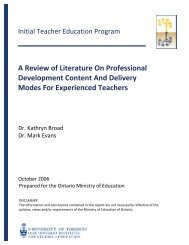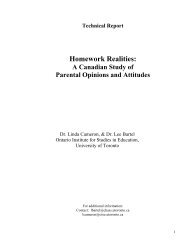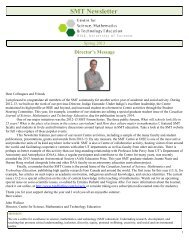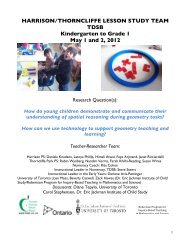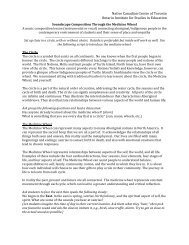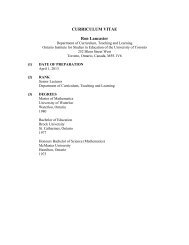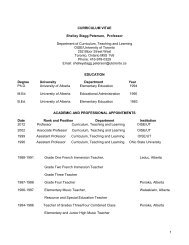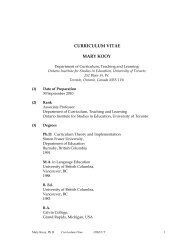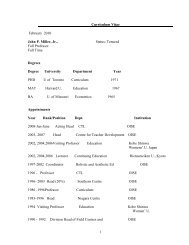The Ontario Curriculum, Grades 9-12 - Ministère de l'éducation ...
The Ontario Curriculum, Grades 9-12 - Ministère de l'éducation ...
The Ontario Curriculum, Grades 9-12 - Ministère de l'éducation ...
Create successful ePaper yourself
Turn your PDF publications into a flip-book with our unique Google optimized e-Paper software.
D. Earth and Space Science: <strong>The</strong> Study of the Universe<br />
D1. Relating Science to Technology, Society, and the Environment<br />
D1.2 assess some of the costs, hazards, and benefits of space exploration (e.g., the expense of<br />
<strong>de</strong>veloping new technologies, acci<strong>de</strong>nts resulting in loss of life, contributions to our<br />
knowledge of the universe), taking into account the benefits of technologies that were<br />
<strong>de</strong>veloped for the space program but that can be used to address environmental and other<br />
practical challenges on Earth (e.g., radiation monitors and barriers, sensors to monitor air<br />
and water quality, remote sensing technology, fire-resistant materials) [AI, C]<br />
Sample issue: Technologies that were originally <strong>de</strong>veloped for space exploration now<br />
have a range of environmental, medical, business, and domestic uses. However, these<br />
technologies were <strong>de</strong>veloped at great cost, using funds that might have been directed to<br />
other types of research and <strong>de</strong>velopment.<br />
Sample questions: What hazards do humans face when they are in space? What<br />
technologies have been <strong>de</strong>veloped in response to these hazards? How have these<br />
technologies been adapted for use on Earth? How much money was spent to <strong>de</strong>velop the<br />
Canadarm? How is Canadarm technology now used in other sectors such as medicine and<br />
the environment?<br />
D3. Un<strong>de</strong>rstanding Basic Concepts<br />
D3.4 <strong>de</strong>scribe the sun’s composition and energy source, and explain how its energy warms<br />
Earth and supports life on the planet (e.g., with reference to the types of radiation the sun<br />
emits and the interaction of the sun’s energy with Earth’s atmosphere)<br />
E. Physics: <strong>The</strong> Characteristics of Electricity<br />
E1. Relating Science to Technology, Society, and the Environment<br />
E1. assess some of the costs and benefits associated with the production of electrical energy<br />
from renewable and non-renewable sources, and analyse how electrical efficiencies and<br />
savings can be achieved, through both the <strong>de</strong>sign of technological <strong>de</strong>vices and practices<br />
in the home<br />
E1.2 assess some of the social, economic, and environmental implications of the production of<br />
electrical energy in Canada from renewable and non-renewable sources (e.g., wind, solar,<br />
hydro, coal, oil, natural gas, nuclear) [AI, C]<br />
Sample issue: <strong>The</strong> operation of wind farms along Lake Huron produces electricity from a<br />
renewable source, reducing <strong>de</strong>pen<strong>de</strong>nce on non-renewable sources of electricity.<br />
However, the wind farms produce noise and visual pollution, affect local animal life, and<br />
reduce the amount of land available for agriculture.<br />
Sample questions: What is the price difference between electricity produced from solar<br />
power and by coal-burning plants? What effects do coal mining, oil production, wind<br />
farms, and hydroelectric dams have on surrounding ecosystems? What types of hazardous<br />
substances are used or created in the production of solar power and nuclear power? What<br />
types of emissions are produced by coal-burning and hydroelectric power plants? What<br />
are the effects of these emissions on human health and the environment?<br />
100 Environmental Education, <strong>Gra<strong>de</strong>s</strong> 9−<strong>12</strong>: Scope and Sequence of Expectations, 2011



